![]()
![]()
![]()
Use LEFT and RIGHT arrow keys to navigate between flashcards;
Use UP and DOWN arrow keys to flip the card;
H to show hint;
A reads text to speech;
47 Cards in this Set
- Front
- Back
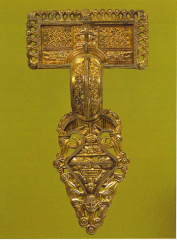
|
Gummersmarck brooch
6th century ce silver gilt Animal, Anglo-Saxon style • art of the migration period |
|
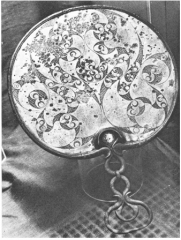
|
bronze mirror with cast handle
1st century bce Desborough, England Anglo-Saxon style |
|

|
purse cover, from Soo Hutton burial ship
1st half of 7th century gold, garnet, enamel (Vikings) Wild Animal, Anglo-Saxon style • the Viking were mast metal-workers • cloisonne • complicated, abstract • from Soo Hutton burial ship, (heroes were buried with their treasure) |
|
|
cloisonne
|
ancient technique for decorating metalwork pieces
|
|
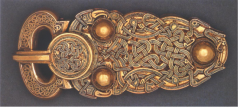
|
golden buckle, from Soo Hutton burial ship
1st half of 7th century Wild Animal, Anglo-Saxon style (Vikings) • intricate, beautiful interlace work • apotropaic: intended magical effect, ability to capture evil spirits • intertwined serpents and eagle heads |
|

|
Memorial stone
Gotland, Sweden 8th century • perhaps illustrating the story of "Gadrun" |
|

|
Oseberg burial ship
815-820 wood Oslo, Norway (Vikings) • beautiful carpentry • extremely strong • pleasure craft |
|

|
post from Oseberg burial ship
815-820 wood (Vikings) Wild Animal style • decorative • apotropaic, meant to give ship power • doesn't have sense of structural mass that Greek art did |
|

|
cross page from "Lindisfarne Gospels"
700 tempera on vellum Wild Animal, Hiberno-Saxon style • colophon • produced in England by monk • wild animal style is now being applied to Christian art • book was considered magical and powerful • cross composed of chalices |
|
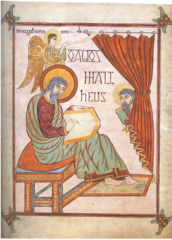
|
St. Matthew, from "Lindisfarne Gospels"
700 tempera on vellum Hiberno-Saxon style • author portrait, strikingly similar to image from "Codex Amiatanus," not accidental, follows common model • language is part Greek, part Latin • Matthew's symbol is the angel • linear, flat form • more Hiberno-Saxon style is shown here than in Ezra |
|
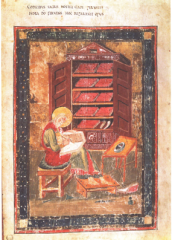
|
Ezra Restoring the Bible from "Codex Amiatanus"
~700 tempera on vellum Hiberno-Saxon style • author portrait, strikingly similar to image from "Lindiafarne Gospels," not accidental, follows common model • from a Florence Bible • lots of light & shadow, very convincing bookcase • more faithful interpretation of of Roman manuscript than "St. Matthew" from "Lindisfarne Gospels" |
|
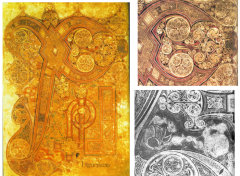
|
Chi Rho Iota monogram page of Book of Matthew of "Book of Kells"
late 8th, early 9th century ce Dublin ink & pigment on vellum Hiberno-Saxon style • one of great treasures of Ireland • combo of Greek & Latin used • insane detail, made with a compass • book was symbol of authority & dominance, since literacy was class-based and rare • animal-style metalwork now being translated to paper, but a little less rigid, and addition of the natural world (animals) and subtle figures |
|
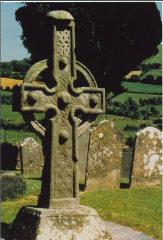
|
South Cross
Ahenny, Ireland stone 8th century Hiberno-Saxon style • interlace style • metalwork translated to stone: gadrooning & bosses |
|
|
gadrooning, bosses
|
metalwork translated to stone
|
|
|
colophon
|
a printer's mark in a book (ex- author page/ author portrait), note at the end of a manuscript
|
|
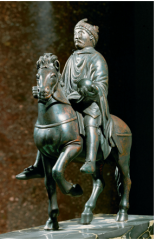
|
Equestrian Statue of a Carolingian Ruler (Charles the Bald?)
9th century bronze (Carolingian empire) • king on horseback • this is the only known bronze equestrian portrait from antiquity • holding orb, signifies domination of the world |
|
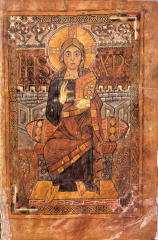
|
Christ Enthroned (from the Gospels of Godescalc)
781-783 tempera on vellum (Carolingian empire) // Roman, Hiberno-Saxon influence • books which Charlamagne commissioned • image of Christ on throne, blessing the book, looking right at us • letters reminiscent of what would be found on Roman capitals or triumphal arches • tension between light & shade and outline • as if the artist is trying to emulate Roman style (drapery) but doing so in a northern manner using linear patterns • Hiberno-Saxon influence |
|
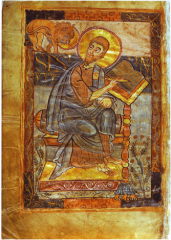
|
Saint Mark
illustration in Gospels of Goldescalc 800 tempera on vellum (Carolingian empire) • taking dictation from lion |
|
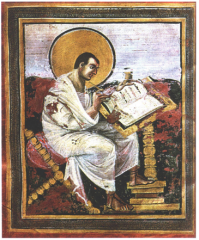
|
St. Matthew
illustration from Gospel "Book of Charlamagne" 800 ink & colors on vellum (Carolingian empire) Heavy Roman influence • modeling of the forms & setting is in nature make it seem extremely Roman • looks very much like Pompeiian wall painting • seems to be thinking, divinely inspired • typical artform of this time was in the Hiberno-Saxon style, a refugee monk probably brought it to Charlamagne while fleeing for his life |
|

|
St . Matthew
illustration in Gospel Book of Ebbo 816-835 ink & colors on vellum (Carolingian empire), Reims style • lots of drapery • Like other image of St. Matthew: eruption of humanism, classical styles • vibrant energy, eruption of motion • more penlike, gestural • worried look, perhaps distantly related to "pathos" • illusionistic |
|
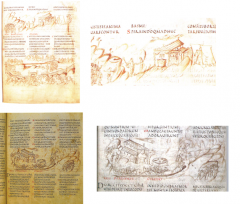
|
pages from famous Book of Psalms "Utrecht Psalter"
816-835 ink on vellum (Carolingian empire // Roman influence, Reims style • psalms are numbered, divided into 3 columns • text like inscriptions on Roman capitals • images like Roman frescoes • purpose of images is to clarify, as opposed to mystify (like Book of Kells) |
|
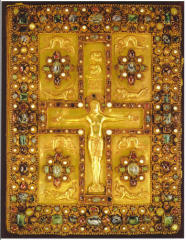
|
Crucifixion with Angels
cover of Lindau Gospels gold, pearls, gems 870-880 (Carolingian empire), Reims style • image of the crucifixion a relatively new thing at this point in time • angels hovering around cross • Christ looks youthful, the piece doesn't emphasize his human nature and suffering, but rather his divine nature |
|

|
Abbey Church of St. Requier
Monastery of Centula, France 799 (engraving dated 1799) (Carolingian empire) • monastery included abbey church, and 2 chapels • large Latin-type basilica (central nave flanked by side aisles ending in transept and apse) |
|
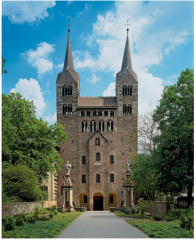
|
Westwork, Abbey Church
late 9th century Corvey, Germany (Carolingian empire) • built in imitation of St. Requien • fortress-like (for practicality as well as a symbol) • "muscular" wall, expressed through use of different planes/layers |
|
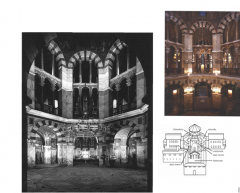
|
Palace Chapel of Charlamagne
Aachen, Germany 792-805 (Carolingian empire) • unlike San Vitale (which was designed to feel other-worldly), it is sturdy and sober. • central plan, modeled on Church of St. Vitale • internal view: Roman colored marble columns, bronze grillwork (some are spolia from Rome, some are made in imitation of Rome) • internal view: throne of Charlamagne in center • octagonal |
|
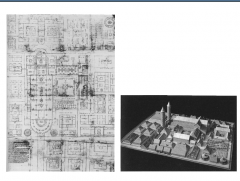
|
Plan of monastery at St. Gall, Switzerland (manuscript page from Swiss monastery) & model constructed on basis of plan
(Carolingian empire) • contains a drawing of an ideal monastery • traditional basilica • numerous entrances • emphasizes church as center of monastic community • also- monks' dormitory, guesthouse, school, abbot's house, infirmary, chapel, novice's quarters, cemetery, garden, small farm |
|
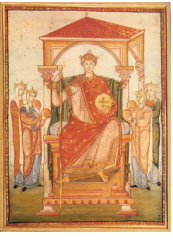
|
Otto Imperator Augustus
detached page from unknown manuscript 985 (Ottonian empire) • France • probably Otto II • surrounded by people who are allegories for provinces of his realm • perspective of roof is super wonky |
|
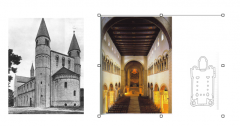
|
St. Cyriakus Church
Gernrode 961 (Ottonian empire) • basic form of Christian basilica, but apse has been raised, addition of crypt • emphasis on verticality rather than horizontality found in early Christian churches • meant to be a nunnery • many churches built during 10th century were not built on a grand scale • use of buttresses give expression of strength • interior: alteration of columns & piers |
|
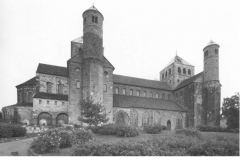
|
Abbey Church of St. Michael
Hildesheim, Germany 1001-1033 (Carolingian empire) • commissioned by Bishop Bernward • one of most famous Ottonian churches • monastic • Otto built lots of impressive churches after 1000 ce, after world failed to end • plan based on church of St. Requien, also recalls church of St. Gall, but much more symmetrical |
|
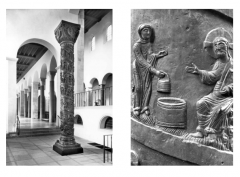
|
bronze column with relief, from St. Michael's church (Germany)
1001-1033 (Carolingian empire) • imitation of column of Trajan • Christ and woman at the well |
|
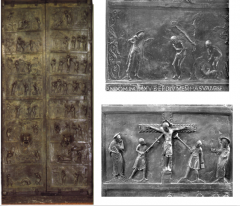
|
pair of bronze doors from St. Michael's church
(Germany) bronze 1001-1033 (Carolingian empire) • composition derives from a manuscript illustration • imitation of Roman doors • shows story of Christ, expressed with extreme directness and force • very famous • amazing, highly energized figures • notoriously sexist - it's all Eve's fault • beautiful writing (like Roman capitals) • Adam & Eve, Crucifixion |
|
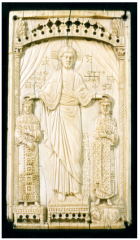
|
Christ Blessing Emperor Otto II and Empress Theopano
ivory (Ottonian empire) 982-983 • composition identical to "Christ Crowning Romanos & Eudokia" • dyptic • illustrates marriage between Otto and princess |
|
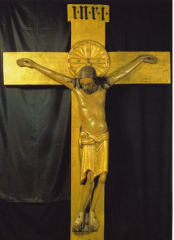
|
Cross of Archbishop Gero (Gero Crucifix)
painted & gilded wood 970 (Ottonian empire) • influenced by middle-Byzantine art, which created the compassionate view of Christ, but this has changed gentle pathos into expressive realism • unlike cover of Lindau Gospels, this doesn't emphasize his divine nature, but rather his human nature & intense suffering • there is a place in the back of the head to hold the Host (so it's a reliquary) • rebirth of imposing monumentality in sculpture, scale of sculpture increased under Ottonian rule • meant to be able to be seen from afar • skin looks stretched • emotional, you're meant to feel catharsis, deep feeling for his suffering, pain looks unbearable |
|
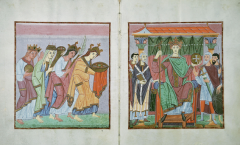
|
"Otto III Receiving Homage of the 4 Parts of the Empire" & "Otto III Between Church and State" (from Gospel Book of Otto III)
1000 ce tempera on vellum (Ottonian empire) • Byzantine & Roman influences • quasi-divine representation of Otto |
|
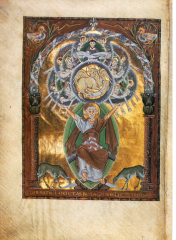
|
Saint Luke (illustration in the Gospels of Otto III)
1000 ce tempera on vellum (Ottonian empire) • very magical-feeling • takes place outside of a specific time and place • inscription: "from the source of the fathers, the ox brings forth a flow of water for the lambs" |
|

|
Christ Washing the Feet of his Disciples (from Aachen Gospels of Otto III)
1000 tempera on vellum (Ottonian empire) • blending of Classical & Byzantine elements • emphasis less on narrative action, more on hieratic style and the divine nature of Christ • buildings symbolize heavenly Jerusalem |
|
|
animal style
|
artistic forms of the Germanic peoples, heavy use of stylized, animal-like forms merged with intricate, ornamental structures of Celts
|
|
|
cenotaph
|
memorial monument to honor a person buried elsewhere (such as a ship)
|
|
|
miniaturist
|
illuminator of a manuscript
|
|
|
turret
|
tower-like projections (like on Lindau Gospels cover)
|
|
|
repousse
|
malleable metal/ other material (gold) is hammered from other side to create low relief
|
|
|
westwork
|
monumental western front of a church, made up of a tower(s) with entrance & vestibules below and chapel & galleries above
|
|
|
tribune
|
gallery of a westwork, platform/ walkway in a church overlooking the nave
|
|
|
abbey
|
religious community headed by an abbot or abbess
|
|
|
cloister
|
open court surrounded by a covered arcaded walk
|
|
|
crypt
|
half-buried basement chapel
|
|
|
reliquary
|
a container to enshrine holy remnants or relics (like Gero Crucifix)
|

